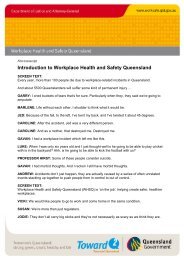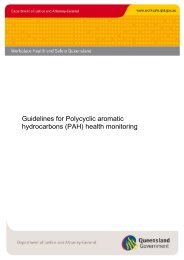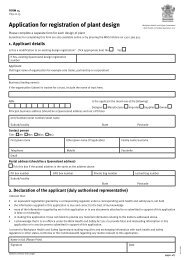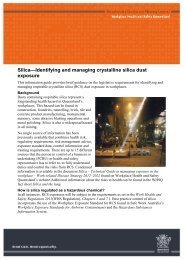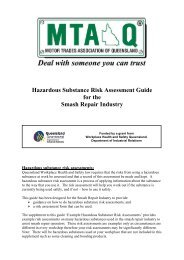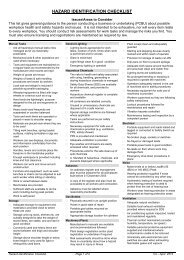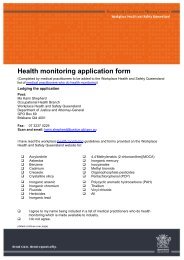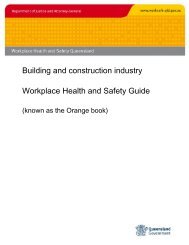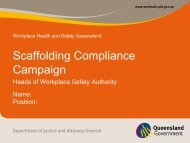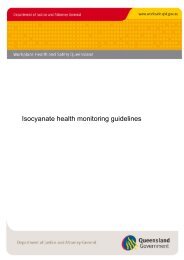Guide to working safely in people's homes - Queensland Government
Guide to working safely in people's homes - Queensland Government
Guide to working safely in people's homes - Queensland Government
You also want an ePaper? Increase the reach of your titles
YUMPU automatically turns print PDFs into web optimized ePapers that Google loves.
Manual tasks<br />
Community service work frequently <strong>in</strong>cludes manual tasks<br />
which also <strong>in</strong>volves the handl<strong>in</strong>g of people <strong>in</strong> their <strong>homes</strong>.<br />
Examples of common manual tasks <strong>in</strong>clude:<br />
• assist<strong>in</strong>g with transferr<strong>in</strong>g, bath<strong>in</strong>g and dress<strong>in</strong>g<br />
clients<br />
• push<strong>in</strong>g wheelchairs<br />
• load<strong>in</strong>g and unload<strong>in</strong>g from vehicles<br />
• mov<strong>in</strong>g furniture<br />
• garden<strong>in</strong>g and ma<strong>in</strong>tenance tasks<br />
• clean<strong>in</strong>g and other domestic tasks.<br />
The risk of <strong>in</strong>jury related <strong>to</strong> manual tasks is <strong>in</strong>creased<br />
when the work requires:<br />
• overreach<strong>in</strong>g<br />
• significant bend<strong>in</strong>g and twist<strong>in</strong>g<br />
• handl<strong>in</strong>g of awkward, large heavy loads<br />
• prolonged hold<strong>in</strong>g of the worker’s body part <strong>in</strong> one<br />
position or do<strong>in</strong>g similar actions for long periods.<br />
Commonly it is a comb<strong>in</strong>ation of these fac<strong>to</strong>rs that<br />
<strong>in</strong>creases the risks.<br />
Types of <strong>in</strong>juries<br />
The types of <strong>in</strong>juries that can occur from manual tasks are:<br />
• Gradual wear and tear – caused by frequent or<br />
prolonged periods of muscular effort associated with<br />
repeated or cont<strong>in</strong>uous use of the same body parts,<br />
<strong>in</strong>clud<strong>in</strong>g static body positions.<br />
Workplace Health and Safety <strong>Queensland</strong> | Department of Justice and At<strong>to</strong>rney-General<br />
<strong>Guide</strong> <strong>to</strong> <strong>work<strong>in</strong>g</strong> <strong>safely</strong> <strong>in</strong> people’s’ <strong>homes</strong>. PN10797 Version 3 Last updated February 2011<br />
• Sudden damage – caused by <strong>in</strong>tense or strenuous<br />
activity or unexpected movements such as when<br />
people who are be<strong>in</strong>g handled move or change<br />
position suddenly.<br />
Most <strong>in</strong>juries are due <strong>to</strong> wear and tear <strong>in</strong> daily tasks.<br />
Although an <strong>in</strong>jury could appear <strong>to</strong> be the result of an<br />
overload situation, the event that triggered the <strong>in</strong>jury may<br />
have been the ‘last straw’ on already damaged tissues.<br />
What are some of the problems of<br />
<strong>work<strong>in</strong>g</strong> <strong>in</strong> a home environment?<br />
Workers provid<strong>in</strong>g services <strong>in</strong> a home environment could<br />
be faced with:<br />
• <strong>work<strong>in</strong>g</strong> <strong>in</strong> isolation without assistance for team<br />
handl<strong>in</strong>g<br />
• the home not designed for health or personal care<br />
(e.g. low bed heights)<br />
• <strong>work<strong>in</strong>g</strong> <strong>in</strong> restricted work spaces such as small<br />
bathrooms<br />
• the home be<strong>in</strong>g laid out <strong>to</strong> suit the client’s preferences<br />
• a change <strong>in</strong> the client’s physical and mental condition<br />
between visits<br />
• workers from other agencies also provid<strong>in</strong>g assistance<br />
for the client.<br />
How <strong>to</strong> identify problem manual tasks<br />
Not all manual tasks are a hazard. Problem manual tasks<br />
can be identified:<br />
• by walkthrough observations<br />
• by discussions with the clients<br />
• with mobility assessments<br />
• by not<strong>in</strong>g known high risk manual tasks identified by<br />
<strong>in</strong>jury/<strong>in</strong>cident data<br />
• when mak<strong>in</strong>g a change<br />
• after an <strong>in</strong>cident has occurred.<br />
7





